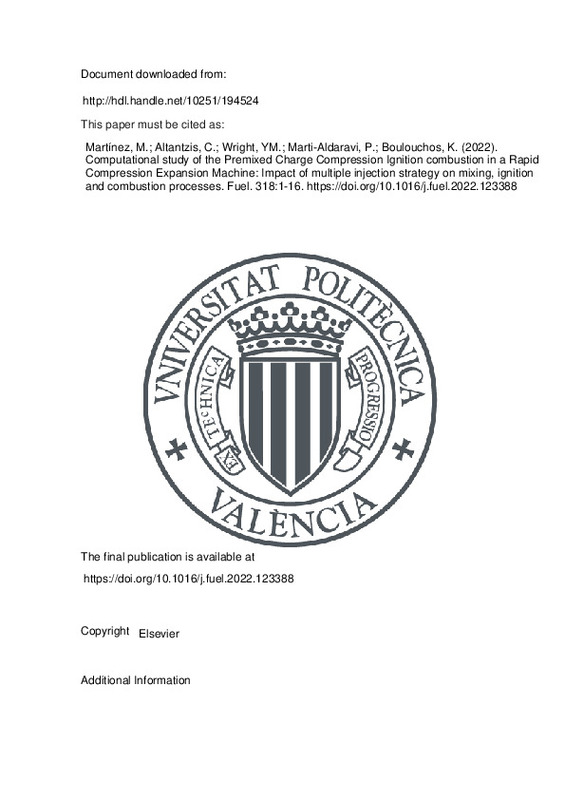JavaScript is disabled for your browser. Some features of this site may not work without it.
Buscar en RiuNet
Listar
Mi cuenta
Estadísticas
Ayuda RiuNet
Admin. UPV
Computational study of the Premixed Charge Compression Ignition combustion in a Rapid Compression Expansion Machine: Impact of multiple injection strategy on mixing, ignition and combustion processes
Mostrar el registro sencillo del ítem
Ficheros en el ítem
| dc.contributor.author | Martínez, María
|
es_ES |
| dc.contributor.author | Altantzis, Christos
|
es_ES |
| dc.contributor.author | Wright, Yuri M.
|
es_ES |
| dc.contributor.author | Marti-Aldaravi, Pedro
|
es_ES |
| dc.contributor.author | Boulouchos, Konstantinos
|
es_ES |
| dc.date.accessioned | 2023-06-23T18:02:20Z | |
| dc.date.available | 2023-06-23T18:02:20Z | |
| dc.date.issued | 2022-06-15 | es_ES |
| dc.identifier.issn | 0016-2361 | es_ES |
| dc.identifier.uri | http://hdl.handle.net/10251/194524 | |
| dc.description.abstract | [EN] Combustion processes operating under the low-temperature (LTC) are a promising alternative for internal combustion engines, achieving high efficiency and low emissions within the legislative framework. Under this field of study, the concept of Premixed Charge Compression Ignition (PCCI) was introduced to control the combustion phase by varying the injection strategy. The present research, based on the aforementioned combustion strategy, employs Computational Fluid Dynamics (CFD) to study the mixing, ignition and initial combustion processes in a Rapid Compression and Expansion Machine (RCEM). The operating conditions of the PCCI strategy are achieved through the split injection technique, which separate the injection into several shots. In this case, the injection strategy consists of a long base injection and two very short, consecutive post injections delivered when the piston is close to the top dead center. Three different operating conditions have been considered which differ mainly in the duration and the starting time of the first injection. Large Eddy Simulations (LES) are selected to account for the effects of turbulence. Results are validated against experimental data, showing good agreement between both approaches. The effect of the first injection on the second one in multiple injection strategy is appreciated as the penetration of the subsequent fuel sprays is faster. Differences in the local mixture field and ignition dynamics are observed as a function of varying operating conditions. The ignition process is highly influenced by the operating strategies affecting the distribution of the mixture and thus the location of the low temperature oxidation. In the current computational study, in addition to the evaporating fuel scalar, the corresponding source term due to evaporation has also been provided to three passive transported scalars, namely three mixture fractions, one for each injection event. This allows for discerning the fuel stemming from each one of the pulses in the overall distribution, thus offering new insights into the effect of the injection strategy. | es_ES |
| dc.description.sponsorship | Authors would like to thank the FVV (Forschungsvereinigung Verbrennungskraftmaschinen | Research Association for Combustion Engines, project "Partially premixed diesel combustion with multiple injections'', no. 1352) and from the Swiss Federal Office of Energy (grant no. Sl/501744-01). Additionally, the Ph.D. student Maria Martinez has been funded by a grant from the Government of Generalitat Valenciana with reference ACIF/2018/118 with financial support from The European Union and a grant for predoctoral stays out of the Comunitat Valenciana with reference BEFPI/2020/057. | es_ES |
| dc.language | Inglés | es_ES |
| dc.publisher | Elsevier | es_ES |
| dc.relation.ispartof | Fuel | es_ES |
| dc.rights | Reconocimiento - No comercial - Sin obra derivada (by-nc-nd) | es_ES |
| dc.subject | Premixed Charge Compression Ignition | es_ES |
| dc.subject | Rapid Compression and Expansion Machine | es_ES |
| dc.subject | CFD | es_ES |
| dc.subject | Large Eddy Simulation | es_ES |
| dc.subject | Mixing and ignition dynamics | es_ES |
| dc.subject.classification | INGENIERIA AEROESPACIAL | es_ES |
| dc.title | Computational study of the Premixed Charge Compression Ignition combustion in a Rapid Compression Expansion Machine: Impact of multiple injection strategy on mixing, ignition and combustion processes | es_ES |
| dc.type | Artículo | es_ES |
| dc.identifier.doi | 10.1016/j.fuel.2022.123388 | es_ES |
| dc.relation.projectID | info:eu-repo/grantAgreement/GENERALITAT VALENCIANA//ACIF%2F2018%2F118//AYUDA PREDOCTORAL GVA-MARTINEZ GARCIA. PROYECTO: COMPUTATIONAL STUDY OF THE INJECTION PROCESS IN GASOLINE DIRECT INJECTION (GDi) engines./ | es_ES |
| dc.relation.projectID | info:eu-repo/grantAgreement/GVA//BEFPI%2F2020%2F057/ | es_ES |
| dc.relation.projectID | info:eu-repo/grantAgreement/FVV//1352//Partially premixed diesel combustion with multiple injections/ | es_ES |
| dc.relation.projectID | info:eu-repo/grantAgreement/SFOE//Sl%2F501744-01/ | es_ES |
| dc.rights.accessRights | Abierto | es_ES |
| dc.contributor.affiliation | Universitat Politècnica de València. Escuela Técnica Superior de Ingeniería del Diseño - Escola Tècnica Superior d'Enginyeria del Disseny | es_ES |
| dc.description.bibliographicCitation | Martínez, M.; Altantzis, C.; Wright, YM.; Marti-Aldaravi, P.; Boulouchos, K. (2022). Computational study of the Premixed Charge Compression Ignition combustion in a Rapid Compression Expansion Machine: Impact of multiple injection strategy on mixing, ignition and combustion processes. Fuel. 318:1-16. https://doi.org/10.1016/j.fuel.2022.123388 | es_ES |
| dc.description.accrualMethod | S | es_ES |
| dc.relation.publisherversion | https://doi.org/10.1016/j.fuel.2022.123388 | es_ES |
| dc.description.upvformatpinicio | 1 | es_ES |
| dc.description.upvformatpfin | 16 | es_ES |
| dc.type.version | info:eu-repo/semantics/publishedVersion | es_ES |
| dc.description.volume | 318 | es_ES |
| dc.relation.pasarela | S\489478 | es_ES |
| dc.contributor.funder | GENERALITAT VALENCIANA | es_ES |
| dc.contributor.funder | Bundesamt für Energie, Suiza | es_ES |
| dc.contributor.funder | Forschungsvereinigung Verbrennungskraftmaschinen | es_ES |







![[Cerrado]](/themes/UPV/images/candado.png)

